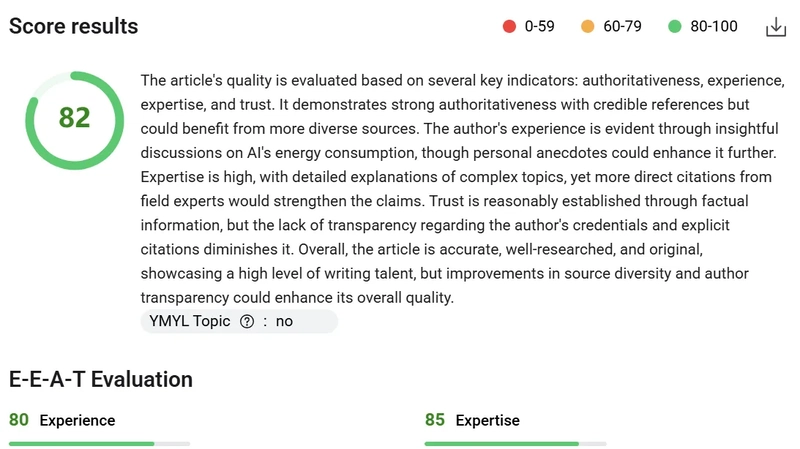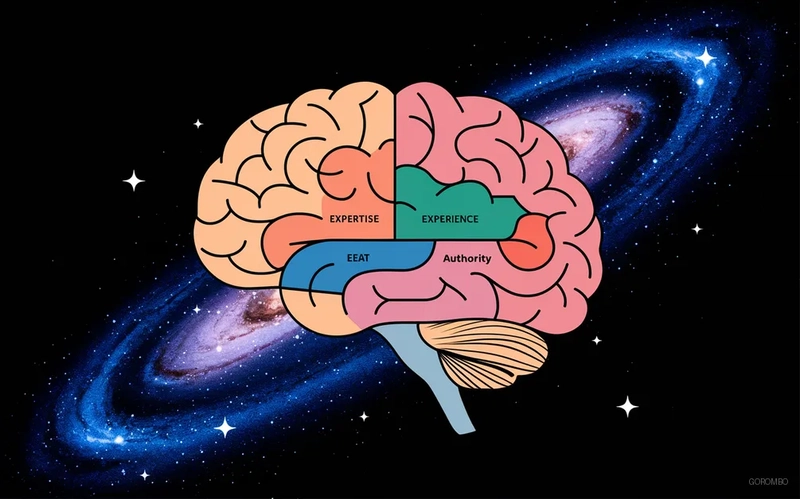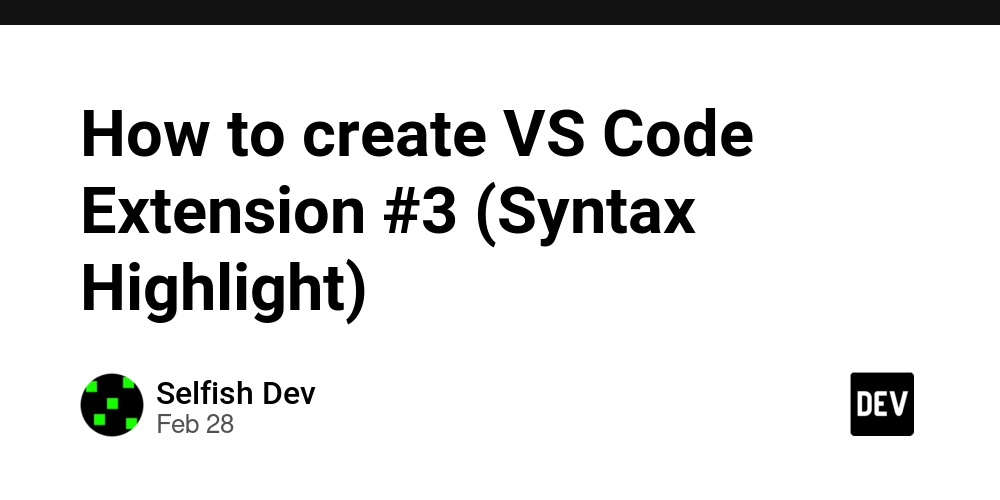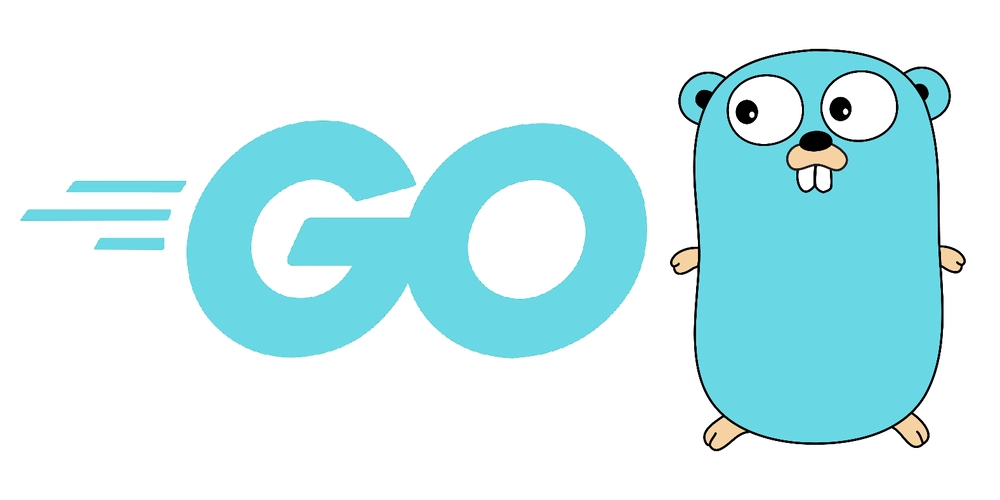How I Scored an 82 in E-E-A-T and Built an SEO Strategy That Thinks Like an AI
Please check out the accompanying podcast episode for this article. You can find it on Spotify or your favorite podcast platform. player.rss.com Table of Contents Introduction From Developer to Strategist: Rewriting My Role Why E-E-A-T Was My Benchmark The Missing Pieces I Had to Confront The Strategic Fixes I Rolled Out 1. Author Attribution 2. Structural Improvements 3. FAQs and Schema Alignment 4. Internal Linking 5. Metadata and Alt Text 6. Visuals and Engagement 7. Ongoing Updates and Navigation Enhancements Using AI as My Business Partner The Results: An E-E-A-T Score of 82 What’s Still Coming The Shift: From Code to Clarity Conclusion: Think Like an Architect, Not an Algorithm About the Author Photo Credits Comments Introduction A year ago, I decided to reveal the man behind the curtain. After years of being the one building systems, developing tools, and quietly optimizing strategies for others, I stepped into a new role: the face of my own startup. And with that, I had one goal in mind—prove that everything I’d learned over the past two decades could be transformed into a strategy that worked in real time, under real pressure, with zero external SEO teams involved. I didn’t want someone else’s strategy. I wanted to prove that my instincts, experience, and understanding of how AI works—and how search engines think—could lead to a scalable, future-ready SEO framework. This is the journey of how I raised my content’s E-E-A-T score from the 60s to 82, and how I turned a technical past into a strategic present—while using AI as more than a tool. I used it as a partner. From Developer to Strategist: Rewriting My Role My background is software and systems. For over 20 years, I’ve been working with code, servers, infrastructure, and development logic. I’ve led projects that built delivery tracking systems still in use today. I’ve handled SEO quietly for years, improving visibility and performance for companies without ever claiming the spotlight. But that changed when I decided to launched my startup, GOROMBO. GOROMBO needed a face. A voice. A story. When we launch this summer, it will be a platform for AI-assisted workflows, safety education, and software integration. It’s a big vision, and I needed to prove that I could not only build the backend but also communicate the value of what we’re doing. And while I could’ve hired an SEO agency or paid $800 a month for a generic content plan, I didn’t. Because I knew what most people don’t: SEO isn’t just keywords and backlinks—it’s structure, strategy, psychology, and increasingly… AI. So I chose to do what I do best: reverse engineer the problem. Why E-E-A-T Was My Benchmark I’d been casually monitoring my site’s performance, but about 3 to 4 months ago, I noticed something specific: my E-E-A-T score was hovering around 60. For those unfamiliar, E-E-A-T stands for Experience, Expertise, Authoritativeness, and Trustworthiness. It’s not a “rank” on its own—but it’s a direct indicator of how well your content aligns with what search engines value. E-E-A-T stands for experience, expertise, authoritativeness, and trust. (What is Google E-E-A-T? Guidelines and SEO Benefits - Moz, 2025) I’d already been working on the content strategy for nearly a year, but that score—60—was a clear signal. There was work to do. I used multiple tools to analyze content quality, but I don’t name them publicly. Not because they weren’t helpful—they were—but because I leave that open for potential partnerships and sponsorships. If someone wants to know which tools I recommend, they are welcome to ask. And while some tools may gauge E-E-A-T differently, I found that they all aligned on the same core principles. They just had different ways of measuring them. But what is more important than the tools I use is the fact that I did use those tools and how I used them. I didn’t just follow suggestions blindly. I used them to validate my gut instinct. I’ve always believed that instruction is available if you’re willing to study. So I read Google’s documentation on E-E-A-T extensively. Not just once—but repeatedly, to extract the nuances. My gut instinct was the strategist. The tools were the advisors. Together, they helped me define the plan. E-E-A-T (Experience, Expertise, Authoritativeness, and Trustworthiness) is a framework that Google's human reviewers use to assess content quality. (Google E-E-A-T: What It Is & How It Affects SEO - Semrush, 2024) The Missing Pieces I Had to Confront When I looked at my content critically, I realized that while it was technically solid and written with care, it was missing the structure Google (and real readers) look for. Some things were absent. Some were just underdeveloped. Some were technically present but not aligned with SEO standards. Here’s what stood out: I had no dedicated author section on most article
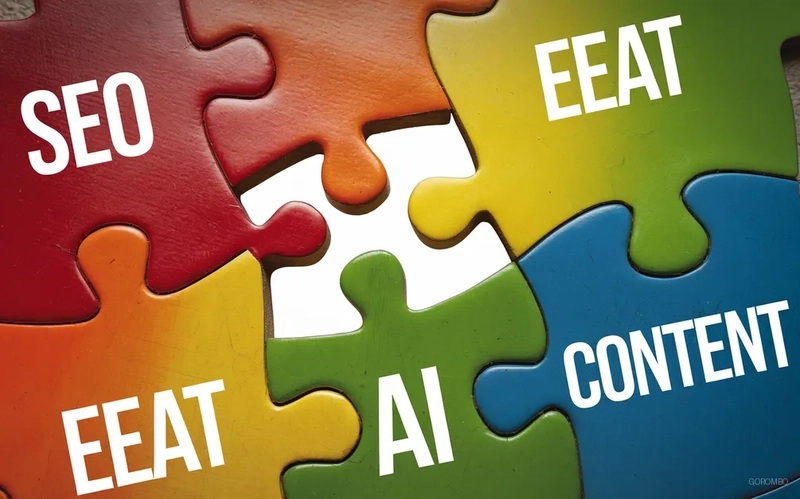
Please check out the accompanying podcast episode for this article. You can find it on Spotify or your favorite podcast platform.
Table of Contents
- Introduction
- From Developer to Strategist: Rewriting My Role
- Why E-E-A-T Was My Benchmark
- The Missing Pieces I Had to Confront
-
The Strategic Fixes I Rolled Out
- 1. Author Attribution
- 2. Structural Improvements
- 3. FAQs and Schema Alignment
- 4. Internal Linking
- 5. Metadata and Alt Text
- 6. Visuals and Engagement
- 7. Ongoing Updates and Navigation Enhancements
- Using AI as My Business Partner
- The Results: An E-E-A-T Score of 82
- What’s Still Coming
- The Shift: From Code to Clarity
- Conclusion: Think Like an Architect, Not an Algorithm
- About the Author
- Photo Credits
- Comments
Introduction
A year ago, I decided to reveal the man behind the curtain.
After years of being the one building systems, developing tools, and quietly optimizing strategies for others, I stepped into a new role: the face of my own startup.
And with that, I had one goal in mind—prove that everything I’d learned over the past two decades could be transformed into a strategy that worked in real time, under real pressure, with zero external SEO teams involved.
I didn’t want someone else’s strategy.
I wanted to prove that my instincts, experience, and understanding of how AI works—and how search engines think—could lead to a scalable, future-ready SEO framework.
This is the journey of how I raised my content’s E-E-A-T score from the 60s to 82, and how I turned a technical past into a strategic present—while using AI as more than a tool. I used it as a partner.
From Developer to Strategist: Rewriting My Role
My background is software and systems.
For over 20 years, I’ve been working with code, servers, infrastructure, and development logic. I’ve led projects that built delivery tracking systems still in use today. I’ve handled SEO quietly for years, improving visibility and performance for companies without ever claiming the spotlight.
But that changed when I decided to launched my startup, GOROMBO.
GOROMBO needed a face. A voice. A story.
When we launch this summer, it will be a platform for AI-assisted workflows, safety education, and software integration.
It’s a big vision, and I needed to prove that I could not only build the backend but also communicate the value of what we’re doing.
And while I could’ve hired an SEO agency or paid $800 a month for a generic content plan, I didn’t.
Because I knew what most people don’t: SEO isn’t just keywords and backlinks—it’s structure, strategy, psychology, and increasingly… AI.
So I chose to do what I do best: reverse engineer the problem.
Why E-E-A-T Was My Benchmark
I’d been casually monitoring my site’s performance, but about 3 to 4 months ago, I noticed something specific: my E-E-A-T score was hovering around 60.
For those unfamiliar, E-E-A-T stands for Experience, Expertise, Authoritativeness, and Trustworthiness. It’s not a “rank” on its own—but it’s a direct indicator of how well your content aligns with what search engines value.
E-E-A-T stands for experience, expertise, authoritativeness, and trust. (What is Google E-E-A-T? Guidelines and SEO Benefits - Moz, 2025)
I’d already been working on the content strategy for nearly a year, but that score—60—was a clear signal. There was work to do.
I used multiple tools to analyze content quality, but I don’t name them publicly. Not because they weren’t helpful—they were—but because I leave that open for potential partnerships and sponsorships. If someone wants to know which tools I recommend, they are welcome to ask.
And while some tools may gauge E-E-A-T differently, I found that they all aligned on the same core principles. They just had different ways of measuring them.
But what is more important than the tools I use is the fact that I did use those tools and how I used them. I didn’t just follow suggestions blindly.
I used them to validate my gut instinct.
I’ve always believed that instruction is available if you’re willing to study. So I read Google’s documentation on E-E-A-T extensively. Not just once—but repeatedly, to extract the nuances.
My gut instinct was the strategist. The tools were the advisors.
Together, they helped me define the plan.
E-E-A-T (Experience, Expertise, Authoritativeness, and Trustworthiness) is a framework that Google's human reviewers use to assess content quality. (Google E-E-A-T: What It Is & How It Affects SEO - Semrush, 2024)
The Missing Pieces I Had to Confront
When I looked at my content critically, I realized that while it was technically solid and written with care, it was missing the structure Google (and real readers) look for.
Some things were absent. Some were just underdeveloped. Some were technically present but not aligned with SEO standards.
Here’s what stood out:
- I had no dedicated author section on most articles.
- FAQ sections were generic or missing entirely—and not tied into schema.
- Citations were weak or nonexistent, even when the content was deeply informed.
- Internal linking wasn’t being leveraged to show site structure and authority.
- Metadata was basic, missing opportunities for richness.
- Visual engagement was limited to spacing and headers—no info-graphics or data visuals.
- My tone was strong, but I hadn’t done enough to support it with trust signals.
Most of the content was there—it just wasn’t activated in a way that both AI and humans would appreciate.
If there is anything that completely envelopes the E-E-A-T framework, it is helpful and high-quality content... Expertise and experience can only be fulfilled with content that is meant to capture the audience through targeted value giving. (6 Ways To Use Google's E-E-A-T To Rank Higher - Surfer SEO, 2024)
The Strategic Fixes I Rolled Out
1. Author Attribution
Being prepared to identify people behind a business contributes to trust... having one or more topic experts attributed to quality content on your blog is another good way to contribute to the trust factor. When you're able to identify the author, you're better able to assess the trust level of the content. (Content Writing with Authority: EEAT Factors and Author Attribution - Article Writers Australia, 2024)
I added a consistent author section to every article.
It didn’t just include my name—it offered contact options, project references, and eventually, a central link to my broader About page. I plan to systematize this even more by making it a site-wide component, detached from individual articles but always present as part of the overall content framework.
2. Structural Improvements
Content Readability: Break up long paragraphs, use bullet points, and include headings to make content easier to skim. (What is e-e-a-t and why does it matter in 2025? - Outranking, 2025)
I enhanced readability with tighter paragraphs, better transitions, and improved visual flow. I didn’t rely on gimmicks—I just respected the reader’s time and focus.
I also began reviewing heading structures and learned that while I was close to optimal, there were some inconsistencies I still needed to iron out.
3. FAQs and Schema Alignment
FAQ schema allows websites to present common questions and answers directly in the search results. It is highly effective for improving user engagement by providing concise answers for conversational queries and can appear in rich results and voice search. (Structured data and SEO: What you need to know in 2025 - Search Engine Land, 2025)
I improved the FAQ section on each article and began the process of connecting each one to dynamic schema—something that helps Google parse the content semantically rather than just visually.
This change alone lifted my clarity score in tool feedback by over 10%.
4. Internal Linking
By leveraging internal linking within a well-structured content strategy, you can unlock the key to demonstrating your website's E-E-A-T and establishing yourself as a trusted resource... They signal to search engines the importance and the interconnectedness of your content. (Internal link building for an E-E-A-T-focused content strategy - Search Engine Land, 2024)
Instead of passively linking articles, I began interlinking content through strategic anchor text, grouping related topics, and building navigation pathways that made sense both to users and crawlers.
5. Metadata and Alt Text
I improved metadata site-wide and started reviewing alt text practices. While I always used alt tags, I realized my SEO performance could benefit from better keyword targeting and descriptive clarity in those tags.
6. Visuals and Engagement
Don't underestimate the power of visuals! High-quality images, videos, and infographics can enhance the perception of expertise. Visuals can make complex information more accessible and engaging while demonstrating a deeper understanding of the topic. (Google EEAT Expertise: What Is It and How Do I Show It? - Aspiration Marketing Blog, 2025)
While I already had visual breaks in place, I began planning true info-graphics and E-E-A-T-relevant visuals—like score progression charts, optimization impact graphs, and mind maps explaining the system.
I also integrated audio and video podcast embeds into my articles, with direct links to listen or watch externally. This multi-format approach helps not just with engagement—but with AI indexing and cross-platform trust.
7. Ongoing Updates and Navigation Enhancements
I began selectively updating older articles with better calls to action, new product links, and embedded social tools.
My site now includes:
- Breadcrumb navigation
- Mobile-first design
- Share buttons
- "Back to top" features
- Audio intros to articles
- Video podcasts above conclusions
- Social follow links and subscription paths
- Policy links for privacy and data use
- A clear About page with my story and mission
- A contact form for direct inquiries
- A Facebook Subscription Hub for exclusive content and early access to new articles
- A community group for discussions and Q&A
In short: it became a dynamic content system, not just a blog.
Quick intermission.
If you are learning anything from this article or any of my other work,
consider buying me a coffee!
Master AI Prompting – Get Your Free AI Prompting Playbook! or get it on Kindle for $9.99.
Don't forget to check out the accompanying podcast episode for this article, where Dan & Chyanne discuss how you can apply this strategy in more detail. You can find it on Spotify or your favorite podcast platform.
Using AI as My Business Partner
Here’s where this strategy goes beyond SEO.
Everything I’ve done over the past year has been in collaboration with AI.
Not just as a tool—but as a partner.
I’ve used AI as:
- A conversational thought partner to refine ideas
- A research assistant to help outline my logic
- A coding assistant to build visual charts
- A proofing engine to catch flow issues
- A creative amplifier when testing angles and voice
I’ve never viewed AI as a replacement for thought leadership.
I view it as a multiplier for it.
That’s why I’m now shifting from hands-on software development to something bigger: consulting on AI strategy and visibility.
I’ve built a process for helping AI find you—a mix of structured metadata, engagement psychology, keyword signal boosting, and format layering. But I’m not giving it away in this article.
What makes this system different is the feedback loop I’ve built into it. Every article, every update, every design tweak is measured, analyzed, and fed back into the content engine—both manually and through AI.
It’s not just content creation. It’s iterative visibility engineering, and I break down exactly how I maintain that loop inside the subscriber section.
That’s reserved for a course I’m developing and the Facebook Subscription Hub where members get early access to ebooks and tactical strategies.
If you want to know how I structure content so AI doesn’t just crawl it—but prioritizes it—you’ll want to follow there.
The Results: An E-E-A-T Score of 82
E-E-A-T significantly influences search engine rankings by providing a framework that algorithmically promotes trustworthy resources in search results and scales quality evaluations. (Decoding Google's E-E-A-T: A comprehensive guide to quality assessment signals - Olaf Kopp, 2024)
The updated articles were run through the same tools that flagged my 60-ish score before.
The result?
82.
That score puts my content in the “high authority” range. But more importantly, it confirmed that the structure and trust signals were now aligned with what modern algorithms and human readers value.
I didn’t get there with keyword stuffing.
I didn’t buy backlinks.
I didn’t run ads to push articles into artificial visibility.
I just did what I’ve always done: study the rules, execute the plan, and iterate relentlessly.
This isn’t just about one score. It’s about setting a replicable foundation that every future article will be built on.
What’s Still Coming
This strategy isn’t static. I’m still actively:
- Refining article-specific FAQ schema
- Optimizing alt text with SEO-rich phrasing
- Improving metadata language
- Systematizing author attribution
- Building visual content tied to article-specific data
- Creating internal processes for ongoing content updates at scale
These final touches aren’t afterthoughts. They’re part of the system.
Because a real strategy never ends—it evolves.
The Shift: From Code to Clarity
This article isn’t just a report.
It’s a transition marker.
I’m no longer the guy just writing backend code or setting up infrastructure for clients behind the scenes.
I’m now the one building frameworks—for AI-assisted visibility, content architecture, and strategy.
If you’re a business owner, startup, or creator who’s tired of vague SEO advice, I’m here.
And if you’re ready to stop chasing gimmicks and start building an actual framework that AI, Google, and real readers can trust, we should talk.
The conclusion is next. But a quick reminder that you can check out the latest insights about this article on our Youtube Podcast below




















































%20Abstract%20Background%20112024%20SOURCE%20Amazon.jpg)






















































































































![[The AI Show Episode 142]: ChatGPT’s New Image Generator, Studio Ghibli Craze and Backlash, Gemini 2.5, OpenAI Academy, 4o Updates, Vibe Marketing & xAI Acquires X](https://www.marketingaiinstitute.com/hubfs/ep%20142%20cover.png)
























































































































































































































































-Nintendo-Switch-2-–-Overview-trailer-00-00-10.png?width=1920&height=1920&fit=bounds&quality=80&format=jpg&auto=webp#)





















_Anna_Berkut_Alamy.jpg?#)













































































































![YouTube Announces New Creation Tools for Shorts [Video]](https://www.iclarified.com/images/news/96923/96923/96923-640.jpg)





































































![[Weekly funding roundup March 29-April 4] Steady-state VC inflow pre-empts Trump tariff impact](https://images.yourstory.com/cs/2/220356402d6d11e9aa979329348d4c3e/WeeklyFundingRoundupNewLogo1-1739546168054.jpg)

























































